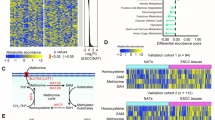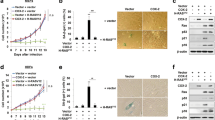Abstract
Methionine aminopeptidase-2 (MetAP2) processes N-terminal methionine from nascent cellular proteins. Inhibition of MetAP2 has been shown to block angiogenesis and suppress tumor growth in preclinical tumor models. However, the biological role of MetAP2 in cancer is not well understood. We examined the effect of three distinct chemical classes of MetAP2 inhibitors on the growth of a panel of human cancer cells in vitro. All MetAP2 inhibitors caused inhibition of tumor cell growth in both anchorage-dependent and, particularly, in anchorage-independent manner. These data prompted us to examine the possible roles of MetAP2 in cancers. Ectopic expression of MetAP2 in NIH-3T3 cells caused transformation, evidenced by the formation of foci in monolayer culture and growth of large colonies in soft agar. Overexpression of MetAP2 in an immortalized bronchial epithelial cell line NL20 accelerated growth. These phenotypes induced by the overexpression of MetAP2 were reversed by the treatment with MetAP2 inhibitors, indicating that the catalytic function of MetAP2 was essential. Accordingly, overexpression of a catalytically inactive MetAP2 resulted in growth retardation of HT1080 tumor cells, suggesting a dominant-negative role of the inactive MetAP2 mutant. Finally, we analysed the expression of MetAP2 in patient cancer samples by immunohistochemistry. Moderate-to-high staining was identified in the majority of breast, colon, lung, ovarian and prostate carcinomas examined. These data suggest that MetAP2 plays an important role in tumor cell growth and may contribute to tumorigenesis.
This is a preview of subscription content, access via your institution
Access options
Subscribe to this journal
Receive 50 print issues and online access
$259.00 per year
only $5.18 per issue
Buy this article
- Purchase on Springer Link
- Instant access to full article PDF
Prices may be subject to local taxes which are calculated during checkout





Similar content being viewed by others
References
Arner ES, Holmgren A . (2006). The thioredoxin system in cancer. Semin Cancer Biol 16: 420–426.
Bernier SG, Taghizadeh N, Thompson CD, Westlin WF, Hannig G . (2005). Methionine aminopeptidases type I and type II are essential to control cell proliferation. J Cell Biochem 95: 1191–1203.
Bradshaw RA, Brickey WW, Walker KW . (1998). N-terminal processing: the methionine aminopeptidase and n alpha-acetyl transferase families. Trends Biochem Sci 23: 263–267.
Bradshaw RA, Yi E . (2002). Methionine aminopeptidases and angiogenesis. Essays Biochem 38: 65–78.
Castronovo V, Belotti D . (1996). Tnp-470 (agm-1470): mechanisms of action and early clinical development. Eur J Cancer 32A: 2520–2527.
Catalano A, Romano M, Robuffo I, Strizzi L, Procopio A . (2001). Methionine aminopeptidase-2 regulates human mesothelioma cell survival: role of bcl-2 expression and telomerase activity. Am J Pathol 159: 721–731.
Datta B . (2000). MAPs and POEP of the roads from prokaryotic to eukaryotic kingdoms. Biochimie 82: 95–107.
Datta B, Datta R . (1999). Induction of apoptosis due to lowering the level of eukaryotic initiation factor 2-associated protein, p67, from mammalian cells by antisense approach. Exp Cell Res 246: 376–383.
Griffith EC, Su Z, Niwayama S, Ramsay CA, Chang YH, Liu JO . (1998). Molecular recognition of angiogenesis inhibitors fumagillin and ovalicin by methionine aminopeptidase 2. Proc Natl Acad Sci USA 95: 15183–15188.
Griffith EC, Su Z, Turk BE, Chen S, Chang YH, Wu Z et al. (1997). Methionine aminopeptidase (type 2) is the common target for angiogenesis inhibitors agm-1470 and ovalicin. Chem Biol 4: 461–471.
Hannig G, Lazarus DD, Bernier SG, Karp RM, Lorusso J, Qiu D et al. (2006). Inhibition of melanoma tumor growth by a pharmacological inhibitor of metap-2, ppi-2458. Int J Oncol 28: 955–963.
Hashimoto S, Onodera Y, Hashimoto A, Tanaka M, Hamaguchi M, Yamada A et al. (2004). Requirement for arf6 in breast cancer invasive activities. Proc Natl Acad Sci USA 101: 6647–6652.
Homsi J, Cubitt C, Daud A . (2007). The src signaling pathway: a potential target in melanoma and other malignancies. Expert Opin Ther Targets 11: 91–100.
Ingber D, Fujita T, Kishimoto S, Sudo K, Kanamaru T, Brem H et al. (1990). Synthetic analogues of fumagillin that inhibit angiogenesis and suppress tumour growth. Nature 348: 555–557.
Kanno T, Endo H, Takeuchi K, Morishita Y, Fukayama M, Mori S . (2002). High expression of methionine aminopeptidase type 2 in germinal center B cells and their neoplastic counterparts. Lab Invest 82: 893–901.
Kruger EA, Figg WD . (2000). Tnp-470: an angiogenesis inhibitor in clinical development for cancer. Expert Opin Investig Drugs 9: 1383–1396.
Kusaka M, Sudo K, Matsutani E, Kozai Y, Marui S, Fujita T et al. (1994). Cytostatic inhibition of endothelial cell growth by the angiogenesis inhibitor tnp-470 (agm-1470). Br J Cancer 69: 212–216.
Kwon YT, Kashina AS, Davydov IV, Hu RG, An JY, Seo JW et al. (2002). An essential role of N-terminal arginylation in cardiovascular development. Science 297: 96–99.
Leszczyniecka M, Bhatia U, Cueto M, Nirmala NR, Towbin H, Vattay A et al. (2006). MAP1D, a novel methionine aminopeptidase family member is overexpressed in colon cancer. Oncogene 25: 3471–3478.
Liu S, Widom J, Kemp CW, Crews CM, Clardy J . (1998). Structure of human methionine aminopeptidase-2 complexed with fumagillin. Science 282: 1324–1327.
Lowther WT, Matthews BW . (2000). Structure and function of the methionine aminopeptidases. Biochim Biophys Acta 1477: 157–167.
Menssen A, Hermeking H . (2002). Characterization of the c-myc-regulated transcriptome by sage: identification and analysis of c-myc target genes. Proc Natl Acad Sci USA 99: 6274–6279.
Mieulet V, Roceri M, Espeillac C, Sotiropoulos A, Ohanna M, Oorschot V et al. (2007). S6 kinase inactivation impairs growth and translational target phosphorylation in muscle cells maintaining proper regulation of protein turnover. Am J Physiol Cell Physiol 293: C712–C722.
Resh MD . (2004). Membrane targeting of lipid modified signal transduction proteins. Subcell Biochem 37: 217–232.
Selvakumar P, Lakshmikuttyamma A, Kanthan R, Kanthan SC, Dimmock JR, Sharma RK . (2004). High expression of methionine aminopeptidase 2 in human colorectal adenocarcinomas. Clin Cancer Res 10: 2771–2775.
Sheppard GS, Wang J, Kawai M, Fidanze SD, Bamaung NY, Erickson SA et al. (2006). Discovery and optimization of anthranilic acid sulfonamides as inhibitors of methionine aminopeptidase-2: a structural basis for the reduction of albumin binding. J Med Chem 49: 3832–3849.
Sin N, Meng L, Wang MQ, Wen JJ, Bornmann WG, Crews CM . (1997). The anti-angiogenic agent fumagillin covalently binds and inhibits the methionine aminopeptidase, metap-2. Proc Natl Acad Sci USA 94: 6099–6103.
Varshavsky A . (2005). Regulated protein degradation. Trends Biochem Sci 30: 283–286.
Vetro JA, Dummitt B, Micka WS, Chang YH . (2005). Evidence of a dominant negative mutant of yeast methionine aminopeptidase type 2 in saccharomyces cerevisiae. J Cell Biochem 94: 656–668.
Wang J, Lou P, Henkin J . (2000). Selective inhibition of endothelial cell proliferation by fumagillin is not due to differential expression of methionine aminopeptidases. J Cell Biochem 77: 465–473.
Wang J, Sheppard GS, Lou P, Kawai M, BaMaung N, Erickson SA et al. (2003a). Tumor suppression by a rationally designed reversible inhibitor of methionine aminopeptidase-2. Cancer Res 63: 7861–7869.
Wang J, Sheppard GS, Lou P, Kawai M, Park C, Egan DA et al. (2003b). Physiologically relevant metal cofactor for methionine aminopeptidase-2 is manganese. Biochemistry 42: 5035–5042.
Wu S, Gupta S, Chatterjee N, Hileman RE, Kinzy TG, Denslow ND et al. (1993). Cloning and characterization of complementary DNA encoding the eukaryotic initiation factor 2-associated 67-kDa protein (p67). J Biol Chem 268: 10796–10801.
Yang G, Kirkpatrick RB, Ho T, Zhang GF, Liang PH, Johanson KO et al. (2001). Steady-state kinetic characterization of substrates and metal-ion specificities of the full-length and N-terminally truncated recombinant human methionine aminopeptidases (type 2). Biochemistry 40: 10645–10654.
Yeh JR, Ju R, Brdlik CM, Zhang W, Zhang Y, Matyskiela ME et al. (2006). Targeted gene disruption of methionine aminopeptidase 2 results in an embryonic gastrulation defect and endothelial cell growth arrest. Proc Natl Acad Sci USA 103: 10379–10384.
Yeh JR, Mohan R, Crews CM . (2000). The antiangiogenic agent TNP-470 requires p53 and p21CIP/WAF for endothelial cell growth arrest. Proc Natl Acad Sci USA 97: 12782–12787.
Zhang Y, Griffith EC, Sage J, Jacks T, Liu JO . (2000). Cell cycle inhibition by the anti-angiogenic agent TNP-470 is mediated by p53 and p21WAF1/CIP1. Proc Natl Acad Sci USA 97: 6427–6432.
Acknowledgements
We thank Drs Milagros Colon-Lopez and Guido Sauter for tissue microarray studies on MetAP2 expression, and Dr Jack Henkin for critical reading of this paper.
Author information
Authors and Affiliations
Corresponding author
Rights and permissions
About this article
Cite this article
Tucker, L., Zhang, Q., Sheppard, G. et al. Ectopic expression of methionine aminopeptidase-2 causes cell transformation and stimulates proliferation. Oncogene 27, 3967–3976 (2008). https://doi.org/10.1038/onc.2008.14
Received:
Revised:
Accepted:
Published:
Issue Date:
DOI: https://doi.org/10.1038/onc.2008.14
Keywords
This article is cited by
-
Amino acid metabolism in health and disease
Signal Transduction and Targeted Therapy (2023)
-
Newly synthesized methionine aminopeptidase 2 inhibitor hinders tumor growth
Drug Delivery and Translational Research (2023)
-
Suppression of glioblastoma growth and angiogenesis through molecular targeting of methionine aminopeptidase-2
Journal of Neuro-Oncology (2018)
-
NC2213: a novel methionine aminopeptidase 2 inhibitor in human colon cancer HT29 cells
Molecular Cancer (2009)
-
Analyzing the binding of Co(II)-specific inhibitors to the methionyl aminopeptidases from Escherichia coli and Pyrococcus furiosus
JBIC Journal of Biological Inorganic Chemistry (2009)



